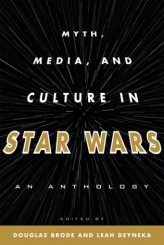There are probably many millions of people worldwide awaiting the new Star Wars episode to be presented in December 2015, including your reviewer here. So even if the book at hand came out some months ago, now is the time to devote some lines to it.
The topics of this volume are subsumed under the headings of “Myth, Media, and Culture,” so in the volume’s thirteen essays subjects such as western movies, fairy tales, heroic archetypes, video games, comic book heroes, technophobia and traces of Akira Kurosawa’s visual style are debated; all, of course, in their relation to the Star Wars saga.
 When part one of the saga was presented in 1977, Hollywood and the American moviegoers were used to anti-establishment protagonists, complicated and rather bleak presentations of reality in their country. Gone were the positive, optimistic heroes who could easily be identified as the ones fighting for justice and the right thing. Even though the 1970s were a decade that produced some of the best American movies ever, the time for the hero – formerly the cowboy, wearing a white hat, as he had some 30 years earlier – seemed to be over.
When part one of the saga was presented in 1977, Hollywood and the American moviegoers were used to anti-establishment protagonists, complicated and rather bleak presentations of reality in their country. Gone were the positive, optimistic heroes who could easily be identified as the ones fighting for justice and the right thing. Even though the 1970s were a decade that produced some of the best American movies ever, the time for the hero – formerly the cowboy, wearing a white hat, as he had some 30 years earlier – seemed to be over.
However, suddenly, with director George Lucas, growing up in the 1950s and still experiencing all the cowboy serials and early science fiction cliffhangers from the 1940s, the return of the hero (and of the Jedi, some years later with director Richard Marquand) finally took place.
To Brode this all makes sense in retrospect: “The first such hero was Luke Skywalker (Mark Hamill) in the original Star Wars movie. … To a degree, Lucas and [Steven] Spielberg re-created the old-fashioned Hollywood that they had loved in their youth. The 1980s, like the 1950s, would as a result largely be an era of what are referred to in the industry as Popcorn Pictures, made for entertainment rather than enlightenment.”
And legend has it, that when Lucas presented his idea for a science fiction movie to 20th Century Fox, he called it an intergalactic adventure movie, something like cowboys in space.
But naturally, there is much, much more to the message, design, myths, visions, politics and conflicts of the saga. Just because it combines so many aspects of various legends, fairy tales, adventures and even religions, it connects so easily with huge audiences.
Myth, Media, and Culture in Star Wars introduces a good sample of that discussion. The book is the companion volume to Sex, Politics, and Religion in Star Wars by the same editors, also reviewed here on popcultureshelf.com.
The texts “Cowboys in Space,” and “Quentin Tarantino’s Star Wars” (on media spoofs, parodies and hidden allusions to the saga) in particular, are well worth going into.
Review by Dr. A. Ebert © 2015
Douglas Brode and Leah Deyneka (eds.) Myth, Media, and Culture in Star Wars: An Anthology. Scarecrow Press, 2012, 192 p.
